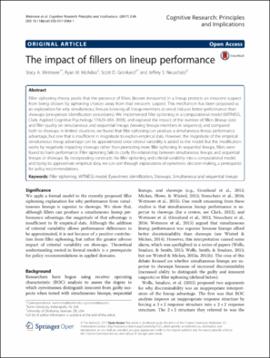| dc.contributor.author | Wetmore, Stacy A. | |
| dc.contributor.author | McAdoo, Ryan | |
| dc.contributor.author | Gronlund, Scott D. | |
| dc.contributor.author | Neuschatz, Jeffrey S. | |
| dc.date.accessioned | 2018-06-21T19:33:35Z | |
| dc.date.available | 2018-06-21T19:33:35Z | |
| dc.date.issued | 2017 | |
| dc.identifier.citation | Wetmore, S. A., McAdoo, R. M., Gronlund, S. D., & Neuschatz, J. S. (2017). The impact of fillers on lineup performance. Cognitive Research: Principles and Implications, 2, 48. https://doi.org/10.1186/s41235-017-0084-1 | en_US |
| dc.identifier.uri | https://hdl.handle.net/11244/300231 | |
| dc.description.abstract | Filler siphoning theory posits that the presence of fillers (known innocents) in a lineup protects an innocent suspect
from being chosen by siphoning choices away from that innocent suspect. This mechanism has been proposed as
an explanation for why simultaneous lineups (viewing all lineup members at once) induces better performance than
showups (one-person identification procedures). We implemented filler siphoning in a computational model (WITNESS,
Clark, Applied Cognitive Psychology 17:629–654, 2003), and explored the impact of the number of fillers (lineup size)
and filler quality on simultaneous and sequential lineups (viewing lineups members in sequence), and compared
both to showups. In limited situations, we found that filler siphoning can produce a simultaneous lineup performance
advantage, but one that is insufficient in magnitude to explain empirical data. However, the magnitude of the empirical
simultaneous lineup advantage can be approximated once criterial variability is added to the model. But this modification
works by negatively impacting showups rather than promoting more filler siphoning. In sequential lineups, fillers were
found to harm performance. Filler siphoning fails to clarify the relationship between simultaneous lineups and sequential
lineups or showups. By incorporating constructs like filler siphoning and criterial variability into a computational model,
and trying to approximate empirical data, we can sort through explanations of eyewitness decision-making, a prerequisite
for policy recommendations. | en_US |
| dc.description.sponsorship | Charges for publication of this article sponsored by University of Oklahoma Libraries Open Access/Subvention Fund. | en_US |
| dc.language | en_US | en_US |
| dc.relation.ispartofseries | Cognitive Research: Principles and Implications;2:48 | |
| dc.relation.uri | https://cognitiveresearchjournal.springeropen.com/articles/10.1186/s41235-017-0084-1 | |
| dc.rights | Attribution 4.0 United States | * |
| dc.rights.uri | https://creativecommons.org/licenses/by/4.0/us/ | * |
| dc.subject | Psychology, Cognitive. | en_US |
| dc.title | The Impact of Fillers on Lineup Performance | en_US |
| dc.type | Article | en_US |
| dc.description.peerreview | Yes | en_US |
| dc.identifier.doi | 10.1186/s41235-017-0084-1 | en_US |
| ou.group | College of Arts and Sciences::Department of Psychology | en_US |

